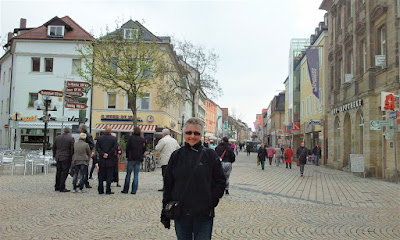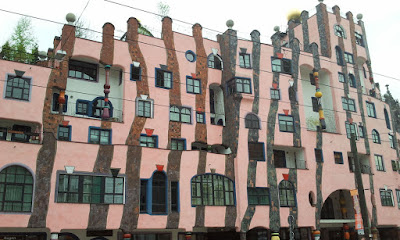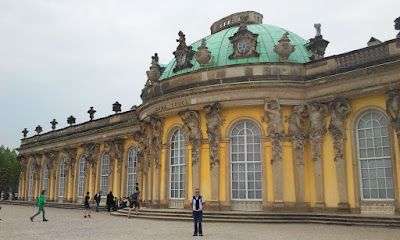 |
| Marg in Nuremburg, Germany |
Driving from Prague in our motorhome Vanni, we headed over the border into Germany aiming for Nuremburg in Bavaria. This ancient city sits on the river Pegnitz and as we crossed one of its many bridges, we had a lovely view of some charming riverside buildings.
As we walked around, the sun suddenly emerged from the grey clouds so we drove quickly to our campsite to do some clothes washing.
Trying to work out how to operate a washing machine with instructions in German was a challenge. We finally got it sorted when we realized we hadn’t shut its door properly!
 |
| Marg with the town walls and castle of Nuremburg, Germany |
We had a short walk the next morning to catch the Ubahn back into Nuremburg where we enjoyed wandering around the old town. We saw Nuremburg Castle, the town walls and the ancient Castle Quarter with its amazing churches and monuments.
Later we stopped at a restaurant and had a traditional lunch - liver ball soup (very yummy) and bratwurst sausages with cabbage. Not long after, we headed back to camp as we'd had seen other parts of Nuremburg last year,
Nuremburg is on the Romantic Road, once a trade route through Bavaria. Now it boasts lovely medieval cities and half-timbered houses (see blog: To the Romantic Road).
 |
| Marg in Bayreuth, Germany |
The next day, still on the Romantic Road, we drove to Bayreuth. We stopped to explore the old town, and had lunch at a quaint café in a tiny side street.
It was nice to get out of a very cold wind and have some warm food. The café was full of happy, chatty locals out for Saturday lunch and very buzzy.
Bayreuth is known for the composer, Richard Wagner. It is a lovely Bavarian city with baroque and rococo architecture that is well preserved in a compact city centre. We managed to see many of its famous sites including the Margravial Opera House, a UNESCO World Heritage Site, and the attractive market square.
 |
| Leigh in the Klein-Venedig area of Bamberg (UNESCO), Germany |
Our next stop was Bamberg, Bavaria. Also on the Romantic Road, this town dates back to the 9th century and is a UNESCO World Heritage Site. Wrapped up for the cold, we walked around the old city to the Klein-Venedig area that is built right on the river. Some of the old buildings were on an alarming lean, but very attractive and well preserved.
We also saw the 14th century town hall built in the middle of the river, the 13th century cathedral, Michaelsberg Abbey, the amazingly intact city wall, and more.
After a long day, we drove to a nearby campsite right on the Danube River for two quiet nights.
Leaving Bamberg and Bavaria, we headed to the centre of Germany to Kassel, the birth place of the Brothers’ Grimm. They wrote most of their fairy tales here and Leigh wanted to see their house (now a museum). However, it was closed so we made do with their statue instead.
We enjoyed a walk around the old town and saw the Hercules monument, and the Lions Castle which is a replica of a medieval castle.
Then we drove north to Bielefeld to get a few things for Vanni. Unfortunately, we hit a major traffic jam on the autobahn and the traffic was blocked further that we could see.
 |
| Bielefeld route trucks |
The inside lane was just truck after truck and we counted 30 from where we had stopped! After about 40 minutes it suddenly cleared.
We decided that this was a very good reason to keep off the autobahns and travel on the main or minor roads.
After getting Vanni sorted in Bielefeld, we drove north, but first, we programmed our GPS “A-rrival” to NOT take autobahns.
However, instead of selecting the main roads, she chose the very very minor roads (perverse machine – grrrr). While the route took us through lots of attractive little villages, the winding roads and considerably lower speed limit meant that we took forever to get to our next destination.
 |
| Vanni parked beside the river in Bremen, Germany |
Eventually we arrived in Bremen and as it had taken us so long to get there, we decided to stop for the night. Upon arriving we followed the camping car signs and found our way to a great little privately owned Stellplatz (overnight parking for camping cars) right near the river.
That afternoon, we took the short walk into the 1200 year old town and discovered that it is compact and quite beautiful.
We first visited the quaint Schnoor quarter which is the oldest part of town. This area is a maze of tiny lanes lined with narrow timber-framed houses from the 15th and 16th centuries.
Nearby was the interesting Böttcherstrasse quarter which is full of Expressionist style architecture.
 |
| Marg outside Bremen Rathaus (UNESCO town hall), Germany |
A short walk away was the Marktplatz (market place) surrounded by the striking UNESCO Rathaus, St Petri Cathedral, and other ornate buildings.
Everywhere we went, we saw statues, artworks and souvenirs of the famous Brothers Grimm fairytale about the Town Musicians of Bremen (a donkey, a cockerel, a dog and a cat riding piggyback).
The next morning, we caught a little ferry that took us to the other side of Bremen’s river. Suddenly, the ferry started spinning in tight circles making us quite dizzy. We think the driver was showing off for the TV crew that was on board, but were very relieved when it stopped!!
 |
| Bremen Universum Science Centre |
We left the next day, and on the drive out, we stopped to view Bremen’s amazing Universum Science Museum which looks like a giant space ship.
From Bremen, we drove south-east to Hannover.
Hannover is a modern city and it was very busy, so we couldn’t find parking for our big motorhome. Instead, we satisfied ourselves with a thorough drive around, seeing the lake surrounded by interesting art, a remarkable office building that looks like a haphazard stack of glass boxes going high into the sky, and the New Town Hall (opened in 1913).
 |
| Marg with half-wooden guild houses in Hildesheim, Germany |
Our next stop was Hildesheim, dating back to before 815. It has an historic market place surrounded by some very beautiful half-wooden buildings, like the Butchers’ Guildhall (1529), the Wernersches house (1606), and the Stadtschänke (Old City Tavern - 1666).
We also liked the 13th century Gothic style town hall, the Tempelhaus, and the Rolandhaus.
Hildesheim has two UNESCO World Heritage Sites that we enjoyed seeing: the 11th century St. Mary's Cathedral, which has a "Thousand-Year-Old Rosebush" apparently the world's oldest living rose, and St. Michael's Church.
 |
| Golden views of the German countryside in Spring |
Driving to our next stop through the German countryside in spring was interesting. While much of the land is still fairly bare, some areas are showing the beautiful bright green of new growth and the dazzling yellow of daffodils and rapeseed.
We were headed to Braunschweig, but ended up 30 minutes further on in Wolfsburg, because somehow, we missed the Braunschweig turn-off. We found a lovely campground in Wolfsburg so we stay a few days to rest.
It rained most days, so we read and caught up on computer time. By the third day, the weather had cleared so we joined the locals in a stroll around the Allersee (a “see” is a lake).
 |
| Leigh and Braunschweig’s Happy Rizzi Building |
We drove to Braunschweig the next day seeing some very interesting architecture. We especially liked the modern ‘Happy Rizzi House’ which is an architecturally extravagant sculpture/apartment designed by New York artist James Rizzi.
Later, we found the local stellplatz. Surrounded by the River Oker and parklands it was a great place to stop - just off a main road, about 18 free parking spaces and electricity at 1 Euro for 8 hours.
When we returned from walking around the city later, we found that our neighbour had mistakenly put his 1 Euro coin in our meter, so we gained 8 free hours of power!
We offered him a euro but he generously refused.
 |
| Marg at at a guild house in Brunschweig, Germany |
The stellplatz was an easy 20 minute walk from to the city centre, so we headed to the old centre and saw the historic buildings in Castle Square, several half-timbered guild houses, the market and the little cobblestoned streets around the Maginkirche.
We stopped for lunch at a little side street café called Mutter Habenicht’s (Mother Hubbard’s), and had Fleischkäse mit 2 Spiegeleiern (meatloaf with 2 eggs) and Hoppel Poppel (Potatoes with ham and scrambled eggs)!
Moving on the next morning we set out for Magdeburg, Brandenburg, and Berlin. However, our GPS had other ideas and took us in a few circles before we finally headed in the right direction.
 |
| Die Grüne Zitadelle building, Magdeburg, Germany |
As a result, we decided to do a ‘drive-through’ of Magdeburg to give us a little longer in Brandenburg. But that was not to be – the drive through Magdeburg worked fine and we saw some wonderful architecture. But, Brandenburg traffic was horrific.
We eventually fought our way out through little side streets and onto the main road again, and drove on toward Berlin.
Unfortunately, a bit further along the main road we were stropped by another major traffic jam. After 40 minutes of crawling, we found an exit lane which we slipped into, and after a zigzag route we eventually arrived in Berlin - but a lot later than planned.
 |
| Marg at the Potsdam camp |
In Berlin, we had decided to go to a city campground because the location sounded great. However, being next to the airport, it was far too noisy, so we drove 30 minutes out of Berlin to Potsdam, where we found a lovely camp on the lake with much better facilities and no loud noise!
The next day, we touched base with Simona, a Berliner who we first met in New Zealand through our friends Sue and Liz. `
As we were to meet Simona in Potsdam, we decided we could cycle to our meeting, so we unpacked the bikes from the back of Vanni, and cycled off.
 |
| Marg at the Sanssoucci Palace, Potsdam, Germany |
En-route, we did a little sight-seeing in Potsdam - exploring Sanssoucci Park and Palace; seeing the ancient Roman Baths; checking out Charlottenhof Palace; enjoying the pretty Babelsberg Park; crossing a tiny one-way bridge in a very old bit of town, and riding a narrow track that followed the river to our meeting place.
We met at café Wirtshaus Moorlake where we ordered spargel (white asparagus) - a German delicacy. It had a more delicate and sweet flavour than our NZ green asparagus.
We had a great time chatting and eating, and organised to meet Monday for a “Simona special” cycle tour of Berlin.
 |
| The Spy Bridge (Glienicke Bridge), Berlin |
It was getting late and cold, so we said our goodbyes and headed back to camp. On the way, we cycled over the Spy Bridge, so called because it formed the border between West Berlin and East Germany, and was used several times in the exchange of captured spies.
We finally arrive back at our campsite, and slept very well that night after our long cycle and yummy food!
It was an early start for us on Monday to ride 10 kms to the Potsdam Haupbahnhof (main train station) and catch the 9am train to Berlin. We paid a little extra to take our bikes on the train, and there were designated areas to travel with them.
 |
| Marg and Simona at the Reichstag, Berlin |
We found Simona at her local station and off we went. Simona was a wonderful guide, and along with her little dog Lucy (who sits in a basket on Simona’s bicycle) we travelled all over the city. One of our first stops was the impressive Reichstag, German Parliament building.
Then we stopped to admire the nearby Bundeskanzleramt Federal Chancellery and saw Angela Merkel, Chancellor of Germany, coming out of the building and boarding a helicopter – then off she flew – what a way to travel.
Our tour, took us through a city full of cycle tracks and where cars give way to you! Wow.
 |
| Marg, Simona and Lucy with Gabriel’s painting on Berlin wall |
Cycling on…..we visited the Berlin Wall and stopped to look at the paintings on what is left of the Wall; especially one by artist Gabriel Heimler who we had met at home in Wellington last year.
Gabriel is the artist who did the wonderful painting on Wellington's Museum Hotel.
Berlin is such a big and diverse city with so much to see and do. Some key places we saw include the Holocaust Memorial, Museum Island (UNESCO), Tiergarten, Charlottenburg Palace, the Berlin Cathedral, Kaiser Wilhelm Gedächtniskirche, Unter den Linden, Oberbaumbruecke (Red brick bridge), and so much more.
 |
| Marg and Simona at the Brandenburg Gate, Berlin |
Nearing sunset, we made a quick dash up to Victoria Park where Simona thought we would get a lovely view over the city, then cycled back through the Brandenburger Tor (Gate).
Then we all realised it was 8pm and the day had just flown by. So we headed towards the railway station where we sadly said goodbye to Simona and Lucy after having such a wonderful day.
Not long after, we caught our train back to Potsdam.
We had seen so much of Berlin with Simona – much more than we would have seen if we’d done it by ourselves. It was great to have such a wonderful guide.
The next day we packed up and headed for our next stop – in Poland.
This blog describes part of our 6-month motorhome trip around northern and eastern Europe, which began in Prague.

Comments
Post a Comment